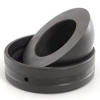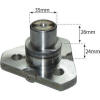|
 |
 |
 |
 |
|
Spherical thrust plain bearings |
Footstep
thrust plain bearings |
| |
|
|
 |
 |
|
Collar
thrust plain bearings |
Multi
Collar thrust plain bearings |
| |
|
|
Taper thrust bearing |
|
|
These types of bearings is not in general use anymore, but is
still found in old centre lathe headstock. It is difficult to
set bearing as two taper bearings on each end of spindle has to
be set up with threaded adjustment nuts. |
| |
|
|
| |
|
Mitchels thrust bearing
(Fluid film thrust bearings) |
Fluid-film thrust bearings were invented by Albert Kingsbury,
who discovered the principle in the course of bearing and
lubrication investigations commencing in 1888 while a student.
His first experimental bearing was tested in 1904. He filed for
a patent in 1907, and it was granted in 1910. The first
Kingsbury bearing in hydroelectric service, one of its major
applications, was installed at the Holtwood Generating Station
in 1912. It remains in full use today.
Thrust bearings were independently invented by Australian
engineer George Michell (pronounced Mitchell) who patented his
invention in 1905.
Fluid thrust bearings contain a number of sector-shaped pads,
arranged in a circle around the shaft, and which are free to
pivot. These create wedge-shaped regions of oil inside the
bearing between the pads and a rotating disk, which support the
applied thrust and eliminate metal-on-metal contact.
Kingsbury and Michell's invention was notably applied to the
thrust block in ships. The small size (one-tenth the size of old
bearing designs), low friction and long life of Kingsbury and
Michell's invention made possible the development of more
powerful engines and propellers. They were used extensively in
ships built during World War I, and have become the standard
bearing used on turbine shafts in ships and power plants
worldwide. (See also Michell/Kingsbury tilting-pad fluid
bearings) |
|
|